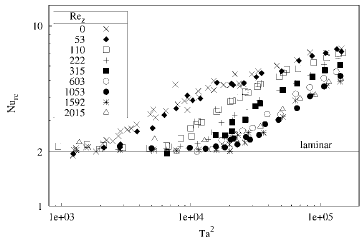Heat Transfer in Annular Ducts with One Rotating Surface
DOI 10.1615/hedhme.a.000183
2.5.16 Heat transfer in annular ducts with one rotating surface
C. Y. Nakashima, S. Oliveira Jr., E. F. Caetano
A. Introduction
Section 151A gives a brief introduction to single phase fluid flow inside annular ducts with rotation of inner surface. In that section, the basic flow patterns that cause the pressure drop to rise are described. The same flow patterns are responsible for a heat transfer enhancement. The behavior of the heat transfer in annular ducts with rotation of inner surface should, therefore, be analyzed bearing in mind the fluid flow behavior.
B. Heat transfer coefficient
Several authors studied the heat transfer between inner and/or outer cylinders and the fluid flowing inside rotating annular channels. Even though the heat transfer is a complex function of several parameters (fluid characteristics, operational conditions, heating or cooling among others), it is possible to summarize the data in a general pattern in terms of Nusselt number, Taylor number and Reynolds number. This is exemplified by the experimental data of Becker and Kaye (1962) for the case of heat transfer from the outer cylinder as shown in Figure 1.
... You need a subscriptionOpen in a new tab. to view the full text of the article. If you already have the subscription, please login here

